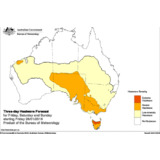Australia Day: Severe heatwave conditions forecast for SA, Vic and Tasmania over long weekend
Author: ABC News Date Posted:25 January 2018

Current forecasts suggest large parts of south-east Australia will be facing severe heatwave conditions over the long weekend, with extreme conditions expected for the north of Tasmania.
Adelaide, Melbourne and Hobart are forecast to have multiple days with maximums 10 degrees above the January average.
If this is sounding familiar, that's because it is. This will be the second severe heatwave warning in south-east Australia in a fortnight.
The heat has been getting a lot of media attention, but it is summer — so are we making a fuss?
And who needs to be paying attention to these warnings?
But first, was last weekend really that bad?
Yes. Daily maximums were in the top 1 per cent of January records for large parts of South Australia, Victoria and Tasmania.
But daily maximums are not the only factor in a heatwave.
The Bureau of Meteorology describes a heatwave as three days or more of high maximum and minimum temperatures that is unusual for a location.
National heatwave project director John Nairn said the overnight minimum and the daily maximum had reached the level of severe heatwave across much of the south-east last weekend.
And the heat had a real impact: There were at least 100 presentations to emergency departments across South Australia alone, and at least 40 people were admitted for heat-related illnesses.
South Australian emergency services were also called to help with 150 heat-related tree-down events.
The forecast for this weekend
The worst of the high temperatures will be on Saturday and Sunday.
Hobart is expected to hit 33 degrees on Saturday, with Melbourne heading for 39 on Saturday and Sunday.
Adelaide is forecast to reach 42 on Saturday and Sunday after a maximum of 38 on Friday.
Before we all mock Tasmania for being soft, we need to remember that heatwaves are all about what you and your infrastructure is used to.
The Tasmanian maximums are relatively low compared to the mainland, but they are unusually high for Tasmania.
The overnight temperatures will also be high, which means high temperatures will be reached earlier the following day, prolonging the exposure to high temperatures and building the heat.
"You will see that … the heat is ramping up through each day," Mr Nairn said.
"It is potentially [only] a three-day heatwave, so we are lucky in that respect, but the temperatures are high and they are getting up to severe levels over a very broad area."
Mr Nairn said it was fortunate Australia Day was early in the heatwave before it would reach its peak.
Who needs to be concerned?
Australia's heatwave warning system has three heatwave severity levels.
Mr Nairn uses playing a game of cricket to describe how to consider the warning levels:
- During a low intensity heatwave, the whole family can be out playing and enjoying the sun, grandparents included.
- But when it becomes severe, it is not a good idea for the grandparents to be outside.
- When you get to an extreme heatwave, why are you playing cricket?
This weekend will be severe for most affected areas, so it will mainly be vulnerable people at risk.
Some parts of Tasmania are currently expected to reach extreme heatwave levels, so if you are in those areas, even the fit and healthy are urged to alter their behaviour to accommodate the heat.
Anyone with doubts about how they should handle the heat should seek professional medical advice.
| Heatwave severity | |
|---|---|
| Low intensity | The level of heat expected is unusual, but injury to people is not generally expected unless inappropriate activities are conducted or sensible precautions are not undertaken. |
| Severe | Vulnerable people are at risk of injury. |
| Extreme | Likely to cause impact across multiple areas such as infrastructure, transport, energy and agriculture. Healthy and vulnerable people are at risk of injury. |
'Vulnerable' includes people already impacted by some form of physical or mental ill-health, the socially isolated, and those in substandard housing or with no access to air conditioning. This group often includes the elderly.
Are we making an unnecessary fuss?
Heatwaves are Australia's deadliest natural disaster. Nearly 500 people died in the 2009 heatwave — that is double the number of people who died in the Black Saturday fires — and, again, 40 people went to hospital in South Australia last weekend.
Mr Nairn and his team take their warnings seriously.
But the big problem with heatwaves is that if you are badly affected, you are affected as an individual.
"You don't see a column of smoke, you won't see the media crowding around the incident saying 'There it is, that's what's happened'," Mr Nairn said.
"If you end up in hospital the medical teams will look after you very efficiently, but they are not about to engage the media over every death or admission into hospital."
Heatwaves are often labelled 'the silent killer' because they do not attract attention.
"All we are doing is supplying the supporting advice for when it becomes dangerous for their family," Mr Nairn said.
"Frequently they're elderly or people who have got disease already. They are vulnerable. I think anything which can be more socially cohesive in looking after each other is a useful tool."
It is true that for most of us this weekend's severe heatwave is not expected to be a matter of life and death, but for some it may be.
"People just need to be conscious that their personal circumstance will change over the course of their life," Mr Nairn said.
So if you are young and fit, enjoy your time in the sun, but be mindful of those around you.



